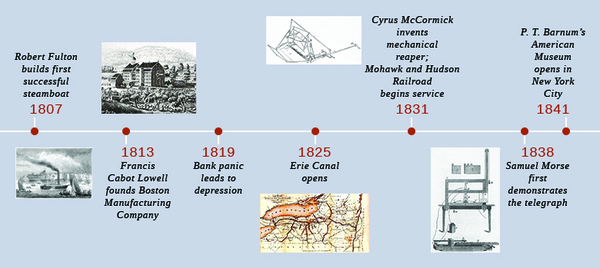| << Chapter < Page | Chapter >> Page > |

Northern industrialization expanded rapidly following the War of 1812. Industrialized manufacturing began in New England, where wealthy merchants built water-powered textile mills (and mill towns to support them) along the rivers of the Northeast. These mills introduced new modes of production centralized within the confines of the mill itself. As never before, production relied on mechanized sources with water power, and later steam, to provide the force necessary to drive machines. In addition to the mechanization and centralization of work in the mills, specialized, repetitive tasks assigned to wage laborers replaced earlier modes of handicraft production done by artisans at home. The operations of these mills irrevocably changed the nature of work by deskilling tasks, breaking down the process of production to its most basic, elemental parts. In return for their labor, the workers, who at first were young women from rural New England farming families, received wages. From its origin in New England, manufacturing soon spread to other regions of the United States.
During the seventeenth and eighteenth centuries, artisans —skilled, experienced craft workers—produced goods by hand. The production of shoes provides a good example. In colonial times, people bought their shoes from master shoemakers, who achieved their status by living and working as apprentices under the rule of an older master artisan. An apprenticeship would be followed by work as a journeyman (a skilled worker without his own shop). After sufficient time as a journeyman, a shoemaker could at last set up his own shop as a master artisan. People came to the shop, usually attached to the back of the master artisan’s house, and there the shoemaker measured their feet in order to cut and stitch together an individualized product for each customer.
In the late eighteenth and early nineteenth century, merchants in the Northeast and elsewhere turned their attention as never before to the benefits of using unskilled wage labor to make a greater profit by reducing labor costs. They used the putting-out system , which the British had employed at the beginning of their own Industrial Revolution, whereby they hired farming families to perform specific tasks in the production process for a set wage. In the case of shoes, for instance, American merchants hired one group of workers to cut soles into standardized sizes. A different group of families cut pieces of leather for the uppers, while still another was employed to stitch the standardized parts together.
This process proved attractive because it whittled production costs. The families who participated in the putting-out system were not skilled artisans. They had not spent years learning and perfecting their craft and did not have ambitious journeymen to pay. Therefore, they could not demand—and did not receive—high wages. Most of the year they tended fields and orchards, ate the food that they produced, and sold the surplus. Putting-out work proved a welcome source of extra income for New England farm families who saw their profits dwindle from new competition from midwestern farms with higher-yield lands.

Notification Switch
Would you like to follow the 'U.s. history' conversation and receive update notifications?